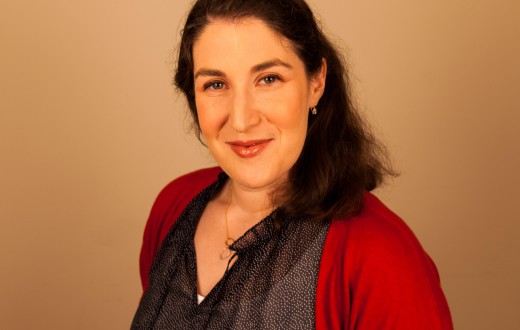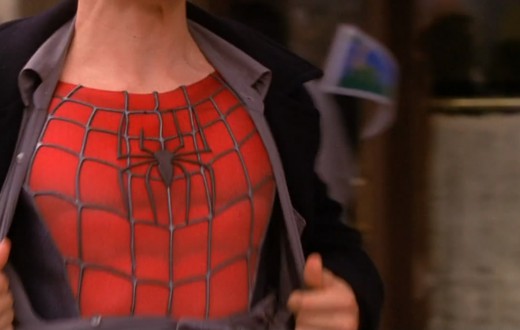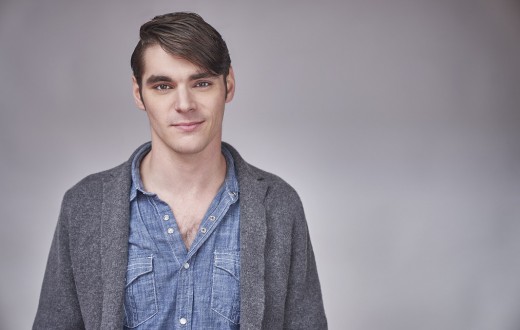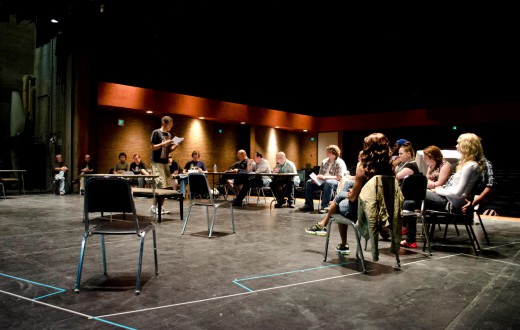An apple a day may keep the doctor away, but what does it take to be that image of health, happiness and a life well lived – that you see in the pages of a magazine?
Deliciousness!
“Warm, friendly, approachable” people who appeal to the senses of American people – are exactly the type that end up in commercial print campaigns, according to the Rick Miller Agency.
Rick Miller developed a keen sixth sense for what the print biz calls ‘marketability’ over his 15 years of print agency experience. He knows what it takes to get started, make the right impression and keep a bright, shiny mental disposition.
Best of all – Rick enjoys helping actors learn more about the commercial print world!
“I like to arm people with information and pride myself on being a straight shooter,” Rick Miller shares with NYCastings. “Whenever I go to a seminar, my goal is to be human, to share the human side of the business as well as what people need to know in order to book jobs.”
At the Rick Miller Agency, “I represent almost 500 people,” Rick Shares. ” I know it sounds like a lot but commercial print is a freelance business and I represent ages 20 through seniors, broken down into Caucasian, Spanish, African American, Indian, ethnically ambiguous” (etc).
When it comes to getting a shot at the D-life (delicious life, of course!) – Rick Miller offered to help NYCastings members get a kick start…
Q&A with Rick Miller of the Rick Miller Agency:
Q: How to Get Started!!!
 First of all, have a great headshot.
First of all, have a great headshot.
When an actor is looking at their headshot, in terms of commercial print, it is about people who are warm, friendly, approachable, and photograph well. They are what I call delicious looking people. You want them at your Thanksgiving table, in your living room with you. When submitting to agencies, for the most part, they want a picture where you smile with teeth showing. And the quality of the shot needs to be very clear. There are certain photographers who know how to shoot people for commercial print. You do not want anything too serious, like legit shots. Nothing too intense.
Also, I like pictures where there is a connection. Commercial look is specific and it is so important that I see something in the eyes, not just a blank stare or a deer caught in the headlights. The eyes should be looking back, as if to say… I am an asset to your company.
There are some people who just happen to have a very marketable look, who are warm, friendly, and approachable with substance. They look right into the picture with a confidence, are relatable and have features that photograph well. From years of experience, I can determine in 5 seconds when I look at a picture who is marketable, who books the jobs consistently.
Q: How to know if you are marketable…
If you have the opportunity to meet someone who is an agent in this area, ask them about your marketability. They may tell you what type they see you as. For example, they might say, “I see you as a young, contemporary mom, kind of hip, living the good life.”
But, to begin with, the best thing to do to is to try and find those good commercial photographers because you will get a great quality picture in clothing that is not too funky or too outrageous with wild patterns. They are on the pulse of what commercial print casting directors are looking for. It is so important to not skimp on your pictures in this business. Your picture is your calling card. If you have a nice warm smile and look comfortable and confident in your skin, then you have a good shot at being called in by someone.
Q: What happens when you meet a print agent?
In the three minutes that I get to spend with someone, a lot of things are going through my mind at the same time. The interview is very light because I want to keep people relaxed, not make them feel as if they are meeting some big agent. I will ask questions about the resume, listen to them talk as themselves and get an impression of what kind of person they are. Do they seem like a positive person? Is their resume laid out well? Do they have a good picture? I am soaking it all in during this very short period time. And it is a huge advantage to meet someone in person because I may get your picture and think I have too many of your type already. If I meet you in person, we can click and that can be the turning point. I may call someone in from that.
Q: WAIT! – What if I have no print experience?
I call in just as many people these days that have a great 8×0 headshot as those who have full comp cards.
Right off the bat, before people come in to meet me, I say during the Q & A that there is no reason to be nervous or to apologize for your pictures. 90% of the people who come in may say, “I know my pictures are terrible, oh commercial print guru.” Of course, I don’t mind someone acknowledging that they are getting new pictures or asking what I think of the picture.
I like to be very positive with people. I don’t want people to walk out devastated that they may not work in print. Instead, in my last seminar, I went over each person’s picture with them and gently shared what could be better, what to be aware of next time the person takes pictures and what type I may see them as.
I like to put people in focus who may have no idea what this industry is looking for and put them on the right track versus some vague mystical, “what are they looking for?”
Q: What happens after you meet a print agent?
Usually, after I meet people at a seminar I go back to the office with all the pictures and go through them. If I think you are a good, marketable type and I can use you at the agency, I will call you. If I call someone into the office, it means you are extremely marketable in my eyes. I may see you as the perfect business woman or a doctor, etc.
If I say, at the seminar, that you have good pictures and then do not call you – that still means you have good pictures and someone else may be interested in calling you.
Q: Is there a certain type that is most marketable or does everyone have a money shot?
Both. There are people who have an incredible marketability where they get put on hold a lot and book many jobs. They are that perfect young dad or mom. They look like real people who just happen to be appealing and photograph well. And then there are people who I take on who are not going to work all the time – I call them my ringers. They are edgier, or different, and they will work sporadically because it all depends on what is going on in the advertising world. There is still a place for them on my roster even if they only book one or two jobs a year.
Q: When you get sent out for a print audition, should actors dress the part?
 Absolutely 100% – you have to go dressed the part because commercial print is all about the look. It is also about being able to act the part. Unlike fashion print where you are a canvas, commercial print is a slice of life caught in a photo image. It is a still image of a television commercial. It is the look that will get you a job.
Absolutely 100% – you have to go dressed the part because commercial print is all about the look. It is also about being able to act the part. Unlike fashion print where you are a canvas, commercial print is a slice of life caught in a photo image. It is a still image of a television commercial. It is the look that will get you a job.
So, if I send you in for IBM and they want to see business executives, it means a suite, shirt, and tie – head to toe. A good agent will tell their talent what the look is. The Casting Director will say “Nice Casual” or “Business Casual.”
Q: YES! Let’s talk more about that. What is your definition of “Nice Casual” or “Business Casual?”
Nice Casual for men – is a button down shirt and khaki pants. No wild patterns or funky logos. Stick with basic colors. For women – it is a simple blouse and a nice pair of pants.
Weekend Casual – could mean polo shirts and khaki shorts.
Hip Casual – is not so middle America looking. You will hear ‘JCrew’ a lot because it is kind of hip where the clothing is tailored nicely. It’s not just a stuffy shirt.
Business Casual for men – will be a buttoned up shirt and a loosened tie. For women – it would be a nice blouse and light weight wool skirt or pants.
Business attire – would be a full suit for men and women. Head to toe. Shoes and everything.
Sometimes, the casting director will be very specific, even about colors. I, in turn, convey all of that information to my talent so they show up looking they way they should and book the job. And you can always ask me to elaborate on what the casting director may be looking for.
Also, they do not want to see people for commercial print who look like they just rolled out of bed. Show up with your clothing, hair and makeup looking nice. You can still look funky, edgy or hip, but do not look like you just rolled out of bed because the pride you have in showing up well-dressed also helps give you a leg up in booking the job.
Q: Are jeans ever appropriate?
If the word “Hip” is used, they can be appropriate. It also depends on the age range. Jeans are definitely ok for people in their twenties because for people in their 20s the words “hip” and “cool” are often used. But if you are in your 30s, then casting directors are often looking for people dressed in a more appropriate way.
Q: At the audition, are there sides or notes available at the sign in area?
At the sign in, they just ask for your name, agency, sizes and sometimes they will ask for your pharmaceutical history.
Your agent may tell you what they are looking for ahead of time. They may say you are part of a football crowd and you are cheering. But for the most part, for print, you do not know until you are in the room and standing on your mark, or sitting on the stool, what the client is looking for.
Most good casting directors will tell you what to do before they snap the picture. If you don’t get any information, I always tell people to simply say, “would you like a smile?” That opens the door for the casting director to tell you what they want. If the job is for a pharmaceutical, they might want you to look sick at first and then feel better with a smile.
And, I always tell newcomers to take a moment and loosen up. If you get nervous or feel stiff, just say to the person casting you, “please let me know when you are going to shoot because I would like to loosen up.” Then, shake it out so you can turn to the camera and smile like you are looking at someone you love. We are all human. There is nothing wrong with saying you want to shake it out first and get comfortable.
Q: Is there an actual camera taking pictures or a video camera?
Most of the time it is just a camera. But, sometimes they will have a video camera because they want to catch how fluid you are, how well you act. They want people who can move, who are real. They want people who have a great look but not someone who is just posing. They want to catch someone who is relaxed and comfortable in that one perfect moment that is so right on, that it all comes together.
Q: Do you get feedback and a second take?
A few years ago they used to pop a couple of Polaroids. These days, for the most part, they pop a couple of digitals. They take anywhere from one to maybe 8.
Q: Are there non-competes in the print world?
Generally when people go in for regular castings they do not ask about conflicts unless it’s for pharmaceutical or financial institutions.
Q: How much work is there in NYC for print?
 I still say that New York City is the Mecca of commercial print. It happens all over the country, but so many of the magazines and ad agencies are here.
I still say that New York City is the Mecca of commercial print. It happens all over the country, but so many of the magazines and ad agencies are here.
Although, it is important to say that the economy has not been good and there may be actors who take it personally, that they are not being called in more often. People are working but advertising budgets are, in my belief, one of the first to be cut. Sometimes it is slow, sometimes very busy. It may be quiet. They may not be looking for your type. I say this so that actors are not wondering why their agent isn’t sending them out more.
Of course, I do believe what goes down must go up. But for now, people should see it as supplemental income, enjoy the process of auditioning, how nice it is to go out and book jobs and to make a nice penny for a day’s work.
Q: Are there main casting agencies who book the lion’s share of print jobs?
I have seen major changes in this business from when I first opened. It used to be the photography studio who did the casting and that happens very rarely now.
Now, there is a core of eight to ten people with an even smaller core of maybe three or four casting directors who seem to be holding the reins of the majority of print jobs in the city. And, within that core, there is one in particular who has been responsible for over 50% of my income over the past two and half years. There was a time when there were thirty to fifty buyers, but it is a small world right now.
Q: Should someone send their headshot to a print casting director, directly?
It certainly doesn’t hurt, but casting directors do not have a lot of time to go through a file of talent on their own. When they get a job, they are going to call Rick Miller or Cunningham-Escott-Slevin-Doherty. Then, when they have time to breathe, they may call someone in on their own.
As a general tool, it does not harm anyone for a casting director to have you on file. Just don’t invest too much emotionally thinking they will call you directly. For the most part, in commercial print, you need to be with a good commercial print agency.
Q: How many people typically get called in for a print job?
Because it has gotten so competitive, most casting directors will call many agents. If they are hiring one person, they might call and ask for 5 of the agent’s best. For castings where they are hiring three, four, five and up, they may be calling in hundreds of people for the auditions. It is big.
I tell my clients to not worry if they do not book every job. I know it is a numbers game and how competitive it is out there.
Q: Is print Union or Non-Union?
Neither. There are no unions in print, no union jurisdiction and probably 90% of my talent base is SAG.
Now, if someone books a print job and they want to use the video on the internet, then that changes the rules. If someone is union, it goes under a SAG contract for that portion. The majority of jobs do not have a camera option to it, 90% are just print. But if they do want to use the video, or an actor for an industrial as well as for print, I come up with a rate for the print and then any kind of on-camera use falls under the guidelines of the Screen Actors Guild.
Q: On a personal note, why do you love being a print agent?
I’ve never lost the enthusiasm that I had when I first started as an agent. I have been in the industry over fifteen years, opened up my own agency in September of 2001 and am going into my tenth year at Rick Miller Agency. To me, I love what I do.
I used to be a print model and will never forget how excited I got when I booked a job and knew that my friends and family would see me. It was incredibly validating to be here in New York City for musical theatre, going out on print auditions and booking jobs for major household companies. I derived so much joy as a commercial print model, many years ago, and I believe I carried that joy with me when I started answering phones at the first talent agency or calling people when I became an assistant. To be able to dispense that kind of joy for people is huge for me. I believe in what I do, I have huge respect for the talent I represent and I treat people the way I want to be treated.
I believe I am doing a service for people, helping them with their careers. To be in that position, is a wonderful thing. It is a business, and it is intense, but I enjoy getting people jobs and doing it well. I am very pleased that I have not changed in my enthusiasm and appreciation for what I do.
And NYCastings is pleased to have learned so many details about the print biz – Thank you Rick Miller! These details are delicious 
For more information please visit: www.rickmilleragencyinc.com







